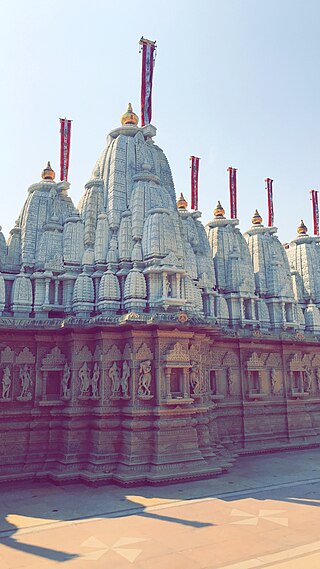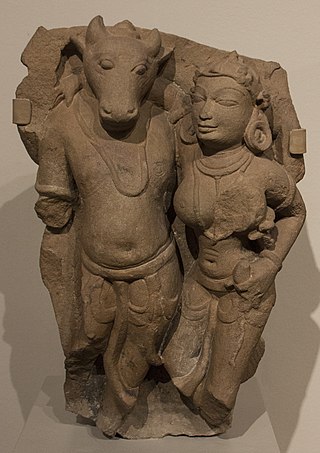Related Research Articles

Sutra in Indian literary traditions refers to an aphorism or a collection of aphorisms in the form of a manual or, more broadly, a condensed manual or text. Sutras are a genre of ancient and medieval Indian texts found in Hinduism, Buddhism and Jainism.

Bhajan refers to any devotional song with a religious theme or spiritual ideas, specifically among Dharmic religions, in any language. The term bhajanam means reverence and originates from the root word bhaj, which means to revere, as in 'Bhaja Govindam' . The term bhajana also means sharing.
Bhakti is a term common in Indian religions which means attachment, fondness for, devotion to, trust, homage, worship, piety, faith, or love. In Indian religions, it may refer to loving devotion for a personal God, a formless ultimate reality or for an enlightened being. Bhakti is often a deeply emotional devotion based on a relationship between a devotee and the object of devotion.

Devaki Jain is an Indian economist and writer, who has worked mainly in the field of feminist economics. In 2006 she was awarded the Padma Bhushan, the third-highest civilian award from Government of India, for her contribution to social justice and the empowerment of women.

Siddhachakra is a popular yantra or mandala used for worship in Jainism. It is also known as Navapada in the Śvetāmbara tradition and Navadevta in the Digambara tradition. In the Śvetāmbara tradition it is associated with the Namokar Mantra. It is related to the legend of King Shripala and his wife Mayanasundari. It is depicted as a Kalasha with the core of a blossomed lotus representing Navapada in the centre surrounded by guarding deities on petals. It is used in some rituals.

Śāntinātha or Śānti is the sixteenth Tīrthaṅkara of Jainism in the present age. According to traditional accounts, he was born to King Vishvasena and Queen Aćira of the Ikshvaku dynasty in the north Indian city of Hastinapur. His birth date is the thirteenth day of the Jyest Krishna month of the Indian calendar. He was also a Chakravarti and a Kamadeva. He ascended to the throne when he was 25 years old. After over 25,000 years on the throne, he became a Jain monk and started his penance.
Amrita Basu is an American academic and political scientist. She currently is a professor at Amherst College where she holds affiliations in the departments of Political Science, Sexuality, Women's, & Gender Studies, Asian Languages & Civilizations, and Black Studies.

The Shankheshwar Jain Temple is located in the center of Shankheshwar town of Patan district, Gujarat, India. The temple is dedicated to Parshwanath and is an important place of pilgrimage for the followers of Jainism.
The study of women and religion examines women in the context of different religious faiths. This includes considering female gender roles in religious history as well as how women participate in religion. Particular consideration is given to how religion has been used as a patriarchal tool to elevate the status and power of men over women. In addition, religion portrays gender within religious doctrines.

Katraj is suburb of Pune in the Indian state of Maharashtra, and within the jurisdiction of Pune Municipal Corporation. Katraj is famous for its Peshwa-era lake that supplied water to the city during that period. The village lies at the foot of the Katraj Ghat or mountain pass on the main National Highway 4 connecting Pune with places south of the city, such as Kolhapur and Bangalore. In recent decades area surrounding the lake and the village of Katraj became part the City of Pune. The former rural area is now surrounded by residential complexes. The lakeside hosts the Rajiv Gandhi Zoological Park. Bharati Vidyapeeth, a deemed university, has its main campus here. A large Jain temple was built here in late 20th century.

Shivajinagar is an inner suburb of the city of Pune, India.

Madhu Khanna is an Indian scholar based in Delhi who works on Indic studies, Religious Studies and Tantric studies. She is a well-known expert on the goddess centric Śakta tantric traditions of India. At present she serves as the Director and founding trustee of Tantra Foundation and Shrikunja. She is also currently serving as a subject expert to the Acarya Shankar Sanskritik Ekta Nyas, set up by the culture department of the Madhya Pradesh government for their Omkareshwar Project. At present she also serves in the academic council of Nalanda University and in the fellowship council of the Indian Institute of Advanced Studies, Shimla. She has many research papers as well as several books and exhibition catalogues to her credit. She has contributed to three national projects, as well as several research projects for the Indira Gandhi National Centre for the Arts (IGNCA).
Jainism and Hinduism are two ancient Indian religions. There are some similarities and differences between the two religions. Temples, gods, rituals, fasts and other religious components of Jainism are different from those of Hinduism.
For the American former baseball player, see Janet Jacobs.

A kautuka is a red-yellow coloured ritual protection thread, sometimes with knots, found on the Indian subcontinent. It is sometimes called a kalava, mauli, moui, raksasutra, pratisara, kaapu, kayiru, charandu or rakshadhara. A kautuka is a woven thread, cord or ribbon, states the Indologist Jan Gonda, which is traditionally believed to be protective or apotropaeic. The pratisara and kautuka in a ritual thread context appear in the Vedic text Atharvaveda Samhita section 2.11. An even earlier reference to ritual "red and black" colored thread with a dual function, one of driving away "fiends" and the other "binding of bonds" between the bride and the groom by one's relatives appears in hymn 10.85.28 of the Rigveda, states Gonda.
Anne Feldhaus is Distinguished Foundation Professor of Religious Studies, Emeritus Professor, at Arizona State University. Her field of specialty is Maharashtra, India, combining philological and ethnographic approaches to study religious traditions of Maharashtra, the Marathi-language region of western India.
Jains are broadly divided into 2 major groups. These include the Digambara, whose clothing displays symbols of cardinal directions, and the Śvetāmbara who wear white clothes. Both of the groups are similar in their ideology but differ in some aspects.

Selling Yoga: from Counterculture to Pop culture is a 2015 book on the modern practice of yoga as exercise by the scholar of religion Andrea R. Jain.

In Jain cosmology, Gomukha is the guardian god or Yaksha of Rishabhanatha, the first Tirthankara.
Nikky-Guninder Kaur Singh, also known as Nikky Singh, is an Indian-born American scholar in Sikhism, and professor and chair of the Department of Religious Studies at Colby College in Waterville, Maine, USA.
References
- 1 2 "M. Whitney kelting". Archived from the original on 2017-06-29. Retrieved 2016-06-12.
- 1 2 "Contributing Scholars". Jainpedia. Retrieved 2016-06-12.